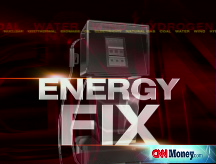U.S. expects big drop in oil imports
Despite the recent drop in crude prices, the rising cost of a barrel of oil will boost the use of renewable energy and help slow greenhouse gas emissions.
NEW YORK (CNNMoney.com) -- Despite the recent rout in oil prices, the government expects crude to shoot back up over the long term. That is expected to result in a drastic drop in oil imports and a greater use of renewable energy.
Oil imports - which currently make up 60% of all the oil consumed in the U.S. - should drop to about 40%, the Energy Information Administration said in its long-term energy outlook on Tuesday.
The drop will largely be the result of higher oil prices encouraging conservation and an expanded use of home-grown biofuels.
In making its predictions, EIA used an average crude price of $130 a barrel in 2030. That price is nearly double the projections for 2030 made last year - $70 a barrel.
Although the report was not meant to predict oil prices, EIA analysts say increased demand and limited access to new supplies will push crude prices up in the long term, despite crude's recent plunge.
The upward revision in price is a major shift in the government's long-term views on oil supply and demand. Limited access to new oil sources - particularly in OPEC countries - is a major reason why prices should increase.
"People are becoming aware of the fact that conventional supplies of oil outside of OPEC are quite limited," said Robert Kaufmann, director of Boston University's Center for Energy & Environmental Studies. "It's getting harder and harder to tell the story that oil prices will remain low forever."
EIA's higher price estimate could give ammunition to policymakers seeking a big push into alternative fuels, or those seeking a more hawkish foreign policy, or both, said Kaufmann.
He said non-OPEC production peaked in 2004, and OPEC countries are expected to provide a greater share of the world's oil going forward.
But OPEC has little incentive to increase its ability to pump oil. The cartel has seen the world is willing and able to pay over $100 for oil, and many OPEC countries have become accustomed to revenues generated from those high prices. For them, the higher the price the better - so long as it doesn't kill the global economy or spur a mass shift away from oil.
EIA's price revision is in-line with predictions made earlier this year by the International Energy Agency (IEA), a similar group to EIA that has a more global focus.
The IEA drastically lowered its long-term world oil supply forecast this spring - from nearly 120 million barrels a day to maybe 100 million per day by 2030 - citing access to resources as a major concern.
In making its predictions, EIA does factor in the growth of supplies from "nonconventional" oil, like oil from tar sands or biofuels made from plants. It also makes its projections based on current policy, which does not include things like laws restricting greenhouse gas emissions, which could potentially drive up the cost of fossil fuels.
Higher oil prices, combined with some government mandates, are expected to yield a boost in renewable energy use as well.
Renewables should account for 21% of all energy used in the U.S. by 2030, the agency said, up from about 15% currently. Last year EIA said renewable use would remain flat at 15% in 2030.
Under current policies, EIA predicts energy-related carbon dioxide emissions will slow in the years ahead, but will increase about 7% by 2030. Last year the agency said carbon dioxide emissions should grow by 15% by 2030.
Most climate scientists say the world needs to cut its carbon dioxide emissions by about 80% by 2050 if it is to avoid the worst effects of global warming. During the presidential campaign, President-elect Barack Obama pledged to cut U.S. emissions by that amount.
The EIA estimates that if the country were to cut its greenhouse gas emissions by 40% in 2030, electricity prices would rise by about 10% due to the costs of switching from cheap coal to more expensive wind or natural gas sources to produce electricity. The agency does not have projections for an 80% reduction by 2050. ![]()



